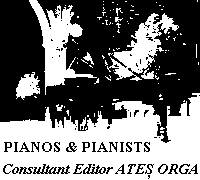 |
PIANOLA TO REPRODUCING PIANO: 1
A Plaine and Easie Introduction
|
"Rhapsodies in Wrapping Paper"
"No Ear Could Tell What You See In The Mirror - That He Plays Without
Touching the Keys. The Biggest Thrill in Music is playing it Yourself.
And now even untrained persons can do it. You can play better by roll
than many who play by hand. And you can play ALL pieces while
they can play but a few" - from a Gulbransen of Chicago "Easy
to Play" advertisement, The Saturday Evening Post, October 17th
1925.
The Idea
The early 20th century self-playing automatic piano - what most people
generically if indiscriminately call the pianola - used pneumatic leverage
to activate the hammers, triggered by a mechanism driven by a paper-roll
(piano roll) of varyingly placed and lengthened perforations corresponding
with the pitches and rhythmic durations of a given piece of music or performance.
Pneumatic systems, calling for greater power at the bass end, were highly
complex technology, including typically: (a) a sensing device (tracker bar
assembly with spaced holes corresponding to each hammer - these allowed
a passage of air to activate the mechanism controlling the hammers); (b)
bellows pump (providing a vacuum supply or wind pressure); (c) reservoir/equaliser
(spring-loaded bellows for storing and regulating the wind supply); (d)
a pneumatic stack (air-activated pouches, valves and bellows); and (e) a
wooden wind-chest (filled with pressurised air). The efficient maintenance
and fine tuning of the pneumatic system was critical to its reliability.
Systems
There were two basic types of system, external and internal.
Pushed up to any quality of grand or upright piano and aligned, the external
- "a small thing," the makers publicised, "an ornamental
cabinet, beautifully proportioned, in oak or mahogany or ebony," price
$250 - had levered "fingers" lying over the keys of the instrument,
servicing them as and when activated. In its original foot-treadled (pumped)
guise - two treadles generating "degree of force and speed, as the
player wills" - it was known as a Piano player, Push-up
or Pianola. In its later electrically-motorised cabinet form, equipped
with felted wooden "fingers" and pedal activating mechanism, it
was called a Vorsetzer (c 1904).
The internal (popularised c 1900), built into the
case of the instrument, and physically connected with the hammer action
via a "striking pneumatic", was known as an Inner Player
or Player piano. With such models the integrated spool/roll-box location
for uprights was usually in the area above the keyboard. For grands it was
either above the keyboard (extending the physical but not the playing length
by up to a foot), or else in a draw below. Compared with the average four
minute side of acoustic 78s of the period, the duration of rolls varied
from around ten minutes to impressive jumbo-spoolings of thirty capable
of sustaining lengthy sonatas (New Ampico Model B, 1929).
Perversions & Practicalities
Doubling as either automatic or manual instruments, most pianos retained
their keyboards. But because the principle of pneumatic action works on
the hammers, not the keys, you don't actually have to have one. There was
a keyless "red Welte" (or Welte Mignon) piano made around 1904,
a purely reproducing invention, with an attachable keyboard to help (understandably)
disorientated tuners. Twenty years earlier, there'd been an even stranger
mutation - a piano without hammers but with strings energised by electromagnets.
From as early as 1899, "transposers" were common to many instruments,
allowing for transposition to up to nine different keys (Hupfeld Phonola)
- useful when accompanying singers. Generally, but not always, transposition
was achieved by shifting the brass tracker bar, so that the perforations
of the roll became re-aligned with new sets of pitch-holes.
© Ates Orga February 5th 1999
Continue >>
|